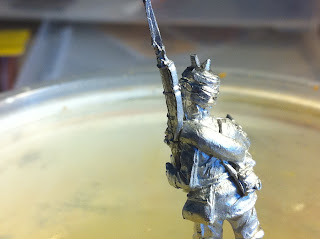These IMHO quite lovely figures are sculpted wearing smooth cloth covers over their turbans, so in order to accurately portray the 1st Bombay Grenadiers at Maiwand, I needed to carve the folds of their lungis (turban wraps) into their headgear and add both a pointed kullah and one end of the lungi poking up from the center of their turbans, as pictured in this illustration from Osprey Men-At-Arms #92, "Indian Infantry Regiments 1860-1914," written by Michael Barthorp, colour plates by Jeffrey Burn, seen here:

It was easy for me to convert a pair of standard bearers in time to use them during the 130th anniversary game last July 27th, but doing it for a full strength infantry unit was a bit more challenging!
The perfect "bits" to serve as kullahs and turban ends came courtesy of the Wargames Foundry FPW Prussian Command Staff pack (seen above!) which I'd already used for British and Afghan command figure conversions. The ribbon-decorated flagpole was the perfect resource, providing 2 separate folds of ribbon, each of which was perfect for use as one of the turban sticking up, and spike at the top of the standard-bearer's helmet, after being filed slightly smoother, made a perfect kullah point sticking out from the center of the turban. But I didn't have anywhere near enough such flagpoles to provide what I needed for the entire unit. So I cast a wider net. I used short lengths of the flagpoles themselves, field to a point on one end, as kullahs, and I used some short & flat lengths of scrap metal, folded over onto themselves to better resemble the ribbons from the Prussian flagpole, as ends poking up from the centers of turbans.
To scrape in the turban folds I used my trusty X-acto blades.
As with the Bengal Lancers in my previous post and nearly all the other conversions I've blogged about, I used a slow-acting superglue called SLO-ZAP which gives you at least 30 seconds to adjust placement of the pieces before they bond together, which for those of us used to working with instantly-bonding krazy glue, is a dream come true.
I like the size and design of these Perry Miniatures figures, so it was worth the time and effort to convert them all... but it did take a while!
Here's some pics (at the bottom are a few pics of the beautifully painted versions, courtesy of Igor Olshansky of Igwargminis.com)...

























Very impressed by your work on these figures and the time it must have taken. Would using Greenstuff for the alterations to the turbans have been easier though?
ReplyDeleteHi Volleyfire,
ReplyDeleteThanks, and yes, you are probably correct about getting quicker adding alterations to turbans by using Greenstuff as opposed to bits and pieces of metal. From time to time on my conversions I use modeling putty to smooth surfaces, fill in gaps, and add texture, but I don't use much Greenstuff. Probably comes from being very "old school" in terms of the conversions I do, which are virtually identical to the ones I started out doing on 15mm Mike's Models colonials back in the early '80s. I did buy some a while back but just never got round to breaking it out of the package, so to speak. With your encouragement I will give it a shot on my next appropriate conversion. Thanks again!
MG that alteration to the turban certainly adds to the unit's appearance lifting it from pretty ordinary drab khaki in the Perry website pictures to eye catching, especially with the colours flying, and the trousers painted a different colour too.I may have to follow your example.
ReplyDeleteRe Greenstuff, I've been buying off eBay lately as its cheaper for more, but it's not the real thing and although it works fine for building up movement bases when basing figures I find it's a lot stickier to use than the stuff from GW and therefore can be trickier to mould. Cheaper isn't always better.
Volleyfire,
ReplyDeleteThey are painted for different campaigns, the Perrys' version for Egypt/early Sudan, mine for Afghanistan 1878-80 in general and Maiwand in extreme particular! But truth be told, I also prefer the slightly more colorful version on purely visual terms.
A lot of work, but the result pays for all: compliments!
ReplyDeleteThanks, abdul666!
ReplyDeleteIt's always great when readers take the time to leave a comment -- especially complimentary ones!